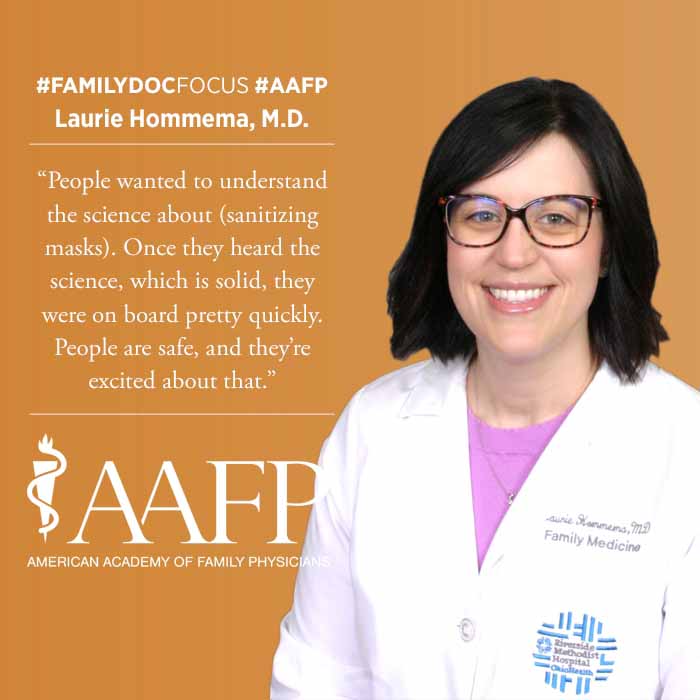Fmily Physician, Husband Play Key Role in PPE Solution
April 20, 2020 02:51 pm David Mitchell – OhioHealth started 2020 with what was projected to be a year's supply of N95 masks, but when COVID-19 arrived in the Buckeye State in early March, projections showed that the stockpile might last less than two months during a surge of cases.

"There were a lot of conversations about (personal protective equipment) and conserving it," said family physician Laurie Hommema, M.D., the medical director of provider and associate well-being for OhioHealth, a not-for-profit network of 12 hospitals and more than 200 ambulatory sites with roughly 30,000 employees. "I was talking about it at home with my husband, and he remembered his company had done a study funded by the FDA."
Mechanical engineer Kevin Hommema wasn't involved with that study, but when his wife said she wished N95 masks could be reused, the image of respirator masks being decontaminated at a Battelle Memorial Institute lab years earlier came back to him.
"He saw those masks every day," Laurie Hommema said. "He remembered that, thank goodness, and helped connect the right people."
The couple's initial dinner-table conversation about masks occurred on March 13, when there were a few hundred confirmed cases of COVID-19 in the state. Hommema read the 2016 study that day and spoke with its lead author, William Richter, a day later about the feasibility of implementing his solution, which uses vaporized hydrogen peroxide. Hommema then took the information to her supervisor and fellow family physician, Doug Knutson, M.D., OhioHealth's vice president of quality and patient safety, who gave her the green light to pursue the sanitation method.
"It's a well-known tool that's widely used," Hommema said. "Battelle built chambers where masks can be exposed to vaporized hydrogen peroxide. There are no hazardous byproducts, and the whole process only takes six to eight hours."
Richter's study, which was conducted in the wake of the 2009 influenza A (H1N1) pandemic, showed that the material of a mask's filter can be sanitized up to 50 times before it begins to break down. Hommema said the elastic in the mask actually breaks down sooner, after about 20 uses.
So, can the elastic be replaced on an otherwise viable mask?
"We're certainly thinking about it if needed," she said.
Leadership from OhioHealth and Battelle met on March 15. A day later, the partners planned to test the process, and OhioHealth started collecting used PPE. Gov. Mike DeWine and President Donald Trump both made pleas to the FDA to allow Battelle, which is based in Columbus, to use its Critical Care Decontamination System on as many as 80,000 masks per chamber per day, and the agency did that on March 29 -- just a little more than two weeks after the Hommemas' initial discussion.
"It was amazing how quickly it worked out," said Hommema, whose role also included working with OhioHealth's directors of sterile processing and environmental services to create processes regarding the marking, collection and redistribution of masks; communications; staff education and onboarding.
Ohio had more than 11,000 confirmed COVID-19 cases as of April 20. Hommema said OhioHealth workers have embraced reuse of the sanitized masks.
"People wanted to understand the science about it," she said. "Once they heard the science, which is solid, they were on board pretty quickly. People are safe, and they're excited about that."
Battelle's system also has been deployed to sites in New York, Boston, Chicago and Tacoma, Wash., as part of a federal contract that is expected to deliver 60 units for distribution through the Federal Emergency Management Agency and HHS by early May.
The Hommemas' role in finding a solution to the mask conundrum landed them on the local news, the Today Show and NBC News and in Time.
"It's been overwhelming," Hommema said of the media attention.
Hommema also has been part of major changes in response to the pandemic at Riverside Family Medicine Residency in Columbus, where she is an associate program director and former program director.
"Our residency leadership has done an incredible job changing the entire curriculum," she said. "Our program director, Dr. Stephen Auciello, and medical director, Dr. Melissa Jefferis, have made incredible decisions to keep our residents, faculty and patients safe. We can't have traditional didactics because of social distancing and the number of people involved, but we still want to provide a great education for our residents."
The program's 18 residents are still completing rotations, but the program has changed the length and cadence of those rotations. After high-risk rotations, such as inpatient family medicine, residents and attendings spend up to two weeks at home doing telemedicine.
"It's a huge change for everyone," she said. "We're trying to limit exposure."